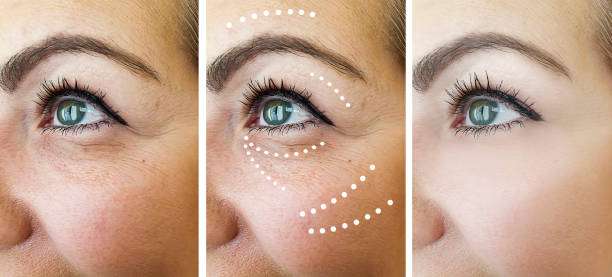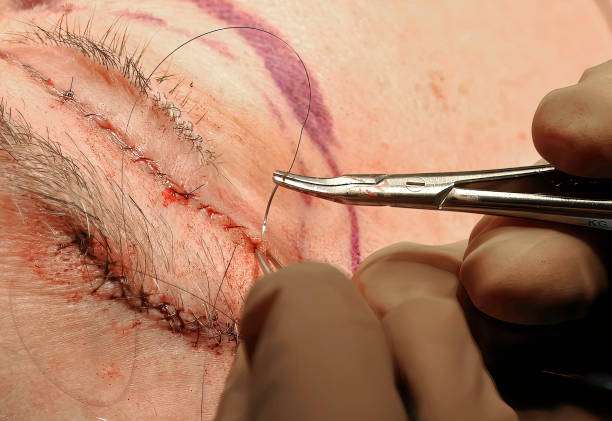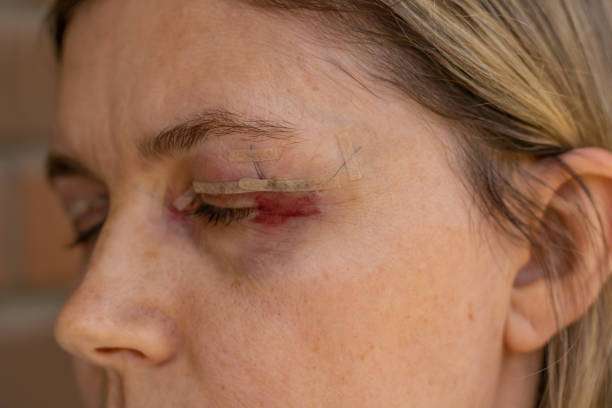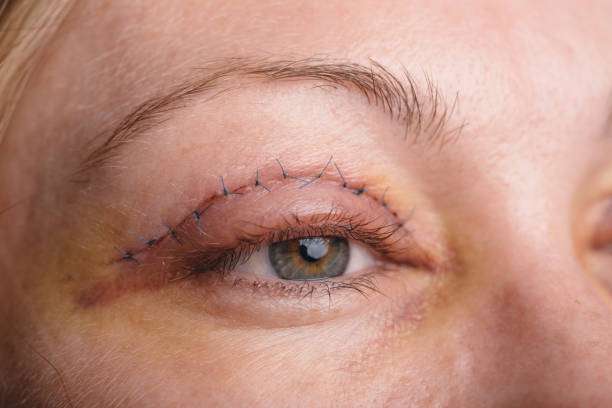What is Blepharoplasty surgery?
Blepharoplasty, otherwise known as an “eye lift”, is a type of surgery that tightens and refreshes the skin around your eyelids by removing any excess skin or puffiness. It’s a very common procedure, especially for those who want to look more awake and youthful. Not only does this surgery remove any vision-impeding factors such as sagging skin or droopy eyelids, but it also brightens up your appearance overall!

Why do people go for blepharoplasty, an eye lift?
Surgeons most commonly perform blepharoplasty, or eyelid surgery, for cosmetic reasons, but it can also effectively improve vision in older individuals. This is because loose, saggy skin around the eyes can sometimes disrupt vision. The surgery removes excess skin and wrinkles from the eye area, resulting in a more natural contour. Eyelid surgery can also help to diminish eye bags and correct drooping lower eyelashes.
Who is the perfect candidate for blepharoplasty?
Good candidates for eyelid surgery include
Individuals with no medical conditions that impede healing, healthy individuals with no serious eye conditions, and individuals with realistic expectations from the surgery. Nonsmokers who are physically, mentally, and emotionally healthy are also good candidates.
What are the different kinds of Blepharoplasty surgery?
Our medical experts have experience with multiple blepharoplasty techniques, including:
– Subciliary Blepharoplasty: This allows for the removal of excess lower eyelid fat.
-Surgeons make the incisions for transconjunctival blepharoplasty inside the lower eyelid, hiding them from view.
– Asian Eyelid Surgery: Surgeons tailor Asian eyelid surgery to the unique anatomy of the Asian eyelid.
For more information on each type of surgery, please see the sections below. If you have any questions or would like to schedule a consultation with our top specialist surgeons, please contact our office.
Upper Blepharoplasty – (Upper Eyelid Lift Surgery)
Upper blepharoplasty, or upper eyelid lift surgery, is a great way to improve the appearance of your eyes. If you have excess skin on your upper eyelids, this surgery can help to remove it and give you a more awake and youthful look. Too much upper eyelid skin can make us look tired and inattentive, and it can also rub and distort makeup.
If you’re considering upper blepharoplasty, be sure to consult with a qualified surgeon to discuss your options and ensure that this is the right surgery for you.
Upper Blepharoplasty (Palpebral Fold Incision)
Upper eyelid surgery, also called blepharoplasty, is a surgical procedure to improve the appearance of the upper eyelids. Surgeons remove excess skin and fatty tissue through an incision in the upper eyelid fold, placing the incision so it remains hidden in the natural arch of the eyelid when the eye is open. The skin on your upper eyelid is thinner than anywhere else on your body, so this incision usually heals quickly and without any problems.
Surgeons can combine upper blepharoplasty with ptosis surgery to correct a drooping eyelid that blocks vision. Ptosis surgery fixes an eyelid that falls over the pupil, obstructing vision.
Excess upper eyelid skin can weigh the eyelid down and block peripheral vision. However, ptosis can also result from stretching, weakness, or detachment of the main muscle that opens the upper eyelid. That’s why doctors must check for ptosis during your blepharoplasty consultation.
Lower Blepharoplasty – (Lower Eyelid Lift Surgery)
Surgeons perform lower blepharoplasty, a cosmetic procedure, to correct bagginess in the lower eyelids. The most common approach involves making a .subciliary incision just below the lash line. Unlike upper blepharoplasty, lower blepharoplasty procedures are less concerned with excess skin and more with addressing the fat that causes the bags in the first place. In most cases, fat in the lower eyelid pushes forward, creating a fuller look and causing bags beneath the eyes, instead of excess skin. Lower blepharoplasty removes or repositions this fat, helping you achieve a smoother, more youthful appearance.
Lower Blepharoplasty (Subciliary Incision)
Subciliary literally means below the hairs, and surgeons place a subciliary incision just below the eyelashes of the lower eyelid. This provides a discreet location and the ability to both remove the excess and tighten the lower eyelid skin. Even more importantly, it allows to removal of any excess lower eyelid fat. Repositioning the lower eyelid fat may work better if you have a hollow adjacent to your lower eyelid bags. Surgeons can remove fat from areas where it is excessive and transplant it to areas where it is lacking, further smoothing the results.
Lower blepharoplasty can also be combined with ectropion repair. Ectropion is a problem with the position of the lower eyelid, where the eyelid droops and gaps away from the eye. This can occur as a normal part of aging or from injury to the lower eyelid. If the eyelid is lax, cosmetic surgery can be performed; however, additional attention is paid to the lower eyelid to physically support and tighten the lid. Checking for lower eyelid laxity is a routine part of your blepharoplasty evaluation.
During your blepharoplasty evaluation, your surgeon will check for lower eyelid laxity. If your eyelid is lax, they may recommend additional surgery to tighten and support the lid.
Lower Blepharoplasty (Transconjunctival Incision)
If you have smooth and tight lower eyelid skin but are suffering from bulging fat pads that cause bags under your eyes, a transconjunctival incision, or lower blepharoplasty, may be the best option for you. This approach uses the conjunctiva, or the moist pink lining of the eyelid, to create an incision along the inside of the lower eyelid. This provides hidden access to the fat pads, without any external scarring.
Asian Blepharoplasty (or Asian Eyelid Surgery)
When it comes to Asian Blepharoplasty (or Asian Eyelid Surgery), there are certain modifications that need to be made in order to achieve the best results. This is because the structure of the Asian eyelid is different from that of the Caucasian eyelid.
For example, additional attachments inside the Caucasian eyelid cause a single dominant fold in the upper eyelid skin, which blocks the eyelid fat from dropping down inside the eyelid.
Therefore, different techniques may be necessary in order to achieve the desired look for Asian patients. However, with the help of a skilled and experienced surgeon, you can be sure that you will get the best possible results.
Asian eyelids typically have less defined upper eyelid folds, often consisting of multiple incomplete folds rather than a single, continuous one. Additionally, the fat in Asian upper eyelids is lower in the lid, contributing to the fullness often seen in these eyelids.
Blepharoplasty Preparation:
You’ll need to make arrangements for someone to drive you home and stay with you the night of your surgery. You should plan to take some time off from work and limit your activities for a few days after your surgery as your eyelids heal. Some people experience dry eyes after surgery, but this is usually only a temporary condition lasting no more than 2 weeks. If you have dry eyes that last longer than 2 weeks, be sure to contact your doctor.
At home, you should have the following items ready:
Ice cubes, an Ice pack (or you can use freezer bags filled with ice, frozen corn, or peas), Small gauze pads, Eye drops or artificial tears (ask your doctor to recommend the proper type to meet your particular needs), Clean washcloths and towels, Over-the-counter painkillers (which your doctor can recommend). Advil, Motrin, Naproxen, Aleve, and aspirin shouldn’t be used due to the increased risk of bleeding. These drugs can thin your blood and make it harder for your body to stop bleeding. If you’re taking any of these drugs, be sure to tell your doctor if you have any cuts or scrapes.
What is the procedure like?
An eye lift procedure usually takes 1-2 hours if both upper and lower eyelids are being worked on together. Local anesthesia will be used (a painkiller injected around the eye) and you will more than likely be given oral sedation. If the procedure is taking place in a hospital or surgical center, then IV sedation will most likely be given.

If you’re getting all four eyelids done, the surgeon will probably work on the upper lids first. The surgeon will usually make incisions along the natural lines of your eyelids. Through these incisions, your surgeon will separate the skin from the underlying tissue and remove any excess fat and skin (and muscle if indicated). Next, the surgeon will close those incisions with very small stitches. The stitches in the upper lids will stay for 3-6 days.
The lower lids may or may not require stitches, depending on the technique used. For more information on this subject, be sure to consult with your doctor or surgeon prior to scheduling any surgeries.
Several different techniques can be employed during lower eyelid surgery. One method involves making an incision on the inside of the lower eyelid to remove any excess fat – this cut will not be visible post-surgery. In addition, your surgeon can also use a CO2 or erbium laser to help smooth out any fine lines in the skin.
Another method of lower eyelid surgery involves making a cut along the lash margin. Through this incision, your surgeon will be able to remove any excess skin, loose muscle, or fat. The cut line usually fades within a short period of time. After either of these procedures, your surgeon may recommend laser resurfacing.
What to expect post-surgery:
Your doctor will most likely put ointment in your eyes and cover them with cold compresses while you’re in the recovery room. Right after surgery, your vision may be blurry from the ointment and you may be sensitive to light. Your eyes may also feel dry or watery.

To help with this, doctors encourage you to put ice packs on your eyes and sleep with your head raised during the first night after surgery. Your doctor will give you more detailed instructions for taking care of yourself before you leave the hospital.
Blepharoplasty Results:
Upper eyelid surgery is effective for 5-7 years on average, while lower eyelid surgery rarely needs to be repeated. Of course, your eyes will still age after the procedure – but if your lids sag again, a forehead lift is likely the preferred procedure over another eyelid lift.
Blepharoplasty Recovery:
After your eyelid surgery, you’ll have stitches in both your upper and lower lids. The stitches usually remain for one to two weeks. It is common to have swelling and occasionally bruising, but your eyelids should look normal within a week or two. Following your surgery, you may return home the same day. The lower lids may or may not require stitches, depending on the technique used. You should avoid any strenuous activity for a week or two and keep your head elevated when you sleep to help reduce swelling.
What are the risks and complications involved?
Though complications and adverse results from an eye lift are not common, they can occur in some cases. These can include:
-Bleeding
-Infection
-Dry eyes
-Abnormal coloring of the eyelids
-Eyelid skin that folds in or out abnormally
-Not being able to fully close your eyes
-A pulled-down lower lid lash line
-A possible loss of vision
If you have any of these complications, it is important to contact your doctor immediately.
How much does Blepharoplasty surgery cost?
The cost of eyelid surgery can range from a few thousand. In addition to the surgeon’s fee, you may also be responsible for the cost of the operating room, anesthesia, and any tests or prescriptions that are required.
Health insurance companies typically don’t cover procedures that are considered cosmetic. However, if you are getting eyelid surgery for a medical reason (such as if your eyelids are drooping so much that it affects your vision), your insurance company may cover it. Be sure to check with your insurance company before you get the surgery so that you know exactly what you will be responsible for paying.
Conclusion:
Blepharoplasty is a surgical procedure that can be used to treat common signs of aging that develop around your eyes. If you’re concerned about excess skin or sagging around your eyes, talk to an ophthalmologist about your options. In some cases, you may not need surgery.

